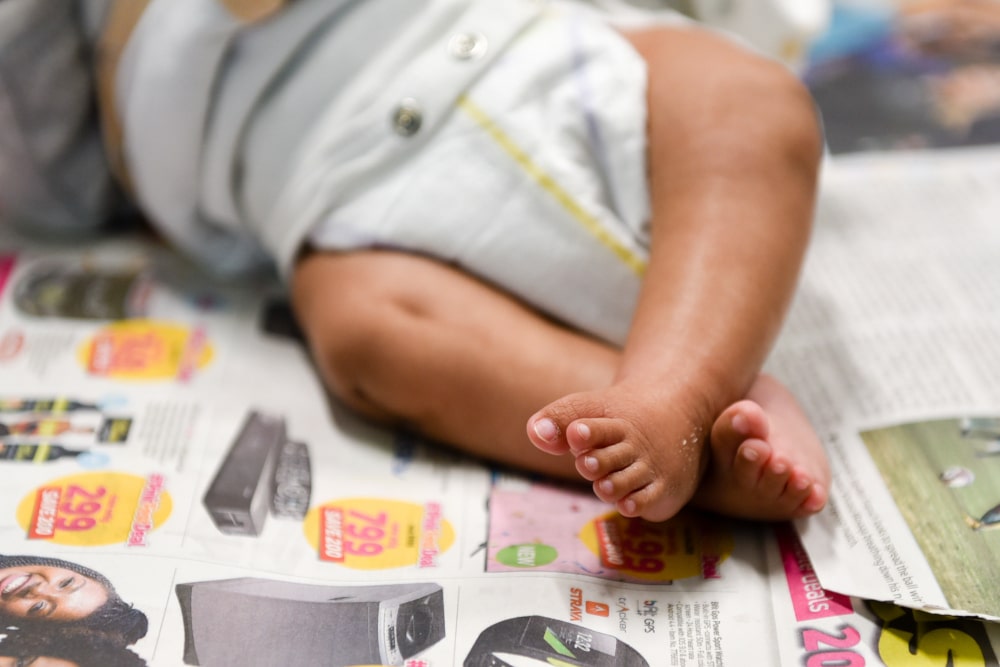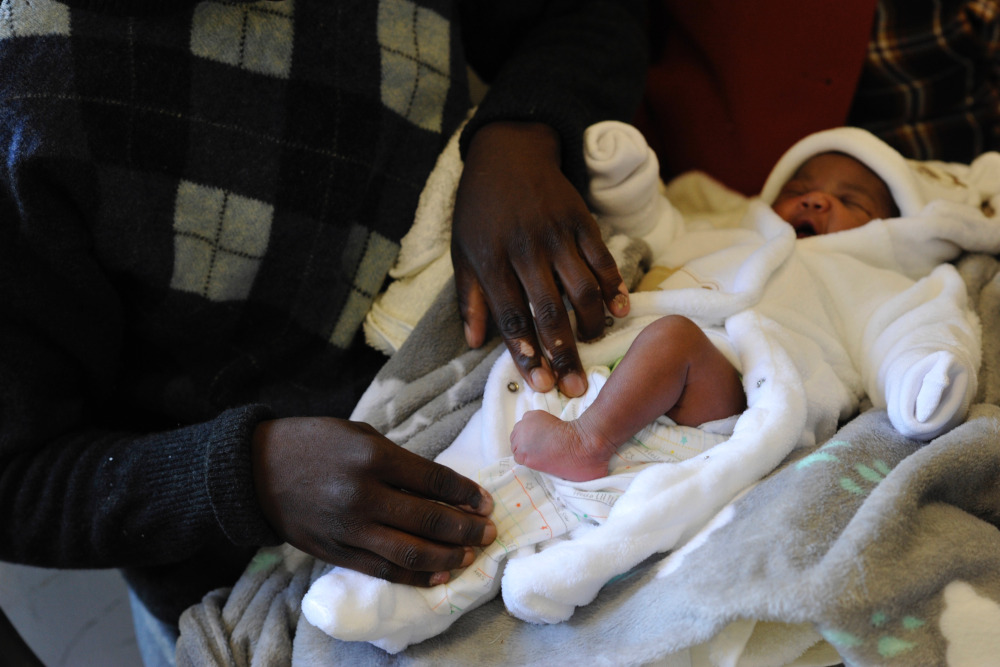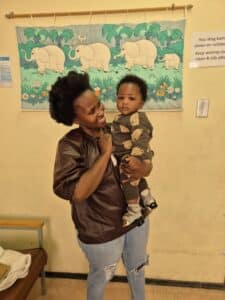These tips should not replace instructions given by a health professional. They are practical advice gathered from other parents and, although every baby is different, most of this should apply in general.

 Bathing with the cast on
Bathing with the cast on
Rather don’t do it. It is really difficult to do with full leg casts on without getting them wet. Lay your baby on a towel, soap up with mild baby soap and rinse off with a damp cloth. Take advantage of all the opportunities during cast changes to let your baby soak in a bath for a while.
Soaking off the casts
You may be asked by your doctor to soak off the plaster casts. It should be done on the morning of your appointment, not the night before. In young babies, the foot can start to lose correction in just a few hours.
 A quick tip is to thoroughly wet some long adult size socks a few hours before and roll them onto the casts. Sit your baby in the bath seat or however you would normally wash your baby. Use warm water with some vinegar added (tip: vinegar helps to soften the plaster faster). Then, with casts completely submerged, squeeze them as they soften star unravelling the bandage bit by bit. Do it carefully, if the bandage tears (it usually does at least once), you have to find the short bit and start working it free all over again.
A quick tip is to thoroughly wet some long adult size socks a few hours before and roll them onto the casts. Sit your baby in the bath seat or however you would normally wash your baby. Use warm water with some vinegar added (tip: vinegar helps to soften the plaster faster). Then, with casts completely submerged, squeeze them as they soften star unravelling the bandage bit by bit. Do it carefully, if the bandage tears (it usually does at least once), you have to find the short bit and start working it free all over again.
By the time the cast is off the bath will probably be murky with plaster of Paris. Bath your baby in some fresh water and apply lots of moisturising cream all over. The exposed skin is quite red and sensitive when it comes out of the plaster and also quite flaky. Just be as gentle and quick as you can and don’t worry about the flaky skin, it’s the skin that would normally be shed by exfoliation, but hasn’t had anywhere to go because of the plaster covering it.
Please note: Dr Ponseti didn’t do it this way in his clinic. He liked to have the casts removed just before he applied the new cast so he could see exactly how the foot had reacted, with no chance for regression overnight. He recommended that on the morning of the appointment the baby has a warm bath with vinegar added. A basin or kitchen sink works fine if you only have a shower. Then wrap the casts with damp towels and cover them with a plastic bag. In Iowa, the nurse would cut off the softened cast in the rooms and then the baby could be washed in the clinic sink, and baby cream used to moisturise the skin before the next cast was applied.
 After casts are applied
After casts are applied
Your baby may be fidgety and seem uncomfortable. This is usually because the casts are quite heavy when first applied until they dry completely. Roll up a small towel or towelling nappy and put it under the knees to relieve the pressure on the heels. If your baby’s really miserable, a dose of paediatric paracetamol syrup like Calpol or Panado helps.
Don’t be too concerned if a tiny baby’s nappy leaks a bit onto a cast. Rub it off as best you can with a wet wipe and leave it. The cast will be removed again in a week anyway.
Check your baby’s toes a few times after the casts are applied to make sure that there was enough circulation. The way to do it is to press lightly on the toes. They will go white, but as soon as you remove your finger they will return quickly to their normal colour. If they don’t, tell your doctor, the cast may be too tight.
Clothing for plaster casts
First of all, ignore all the full leg Baby Grows (all-in-one suits) with the seamed foot. The casts will not fit through them. If that’s all you can find, then buy them a bit bigger so that the baby’s foot will fit into the length of the leg, and you’ll have a little pocket of fabric at the end of the cast where the foot was supposed to fit in. Or just cut the foot part of the Baby Grow off. The Baby Grows that don’t have a seamed foot section are great and they are usually wide enough to fit over the cast.
During colder weather, tracksuit pants, and baby jeans, fitted over casts well. You can stretch towelling socks over the casts to keep the feet warm and dungarees are always useful. Remember that the casts are quite warm, so don’t overdress them. In warm weather, your baby could just sleep in a vest, the legs won’t need any covering other than the casts.
Clothing for the clubfoot brace
In the beginning your baby will wear the brace for three months, 23 hours a day. It only comes off once a day for an hour at bath time. Try to avoid all clothing that can’t be put on over the head. If it’s pants or dungarees, they should fasten all the way round the inside of the leg with poppers. Dresses are also fine. It’s just too much of a hassle to always be removing one shoe to try dress and undress them, and small babies can need several changes through the day.
Also, changing a nappy without the poppers to open up the pants means pulling the pants down. If you have a bar that doesn’t have clip-off shoes, your baby’s legs are held out to shoulder width by the bar. A bonus for nappy changing with the bar on is that it’s so easy to hold it up, keeping both legs out the way.
Getting around
Car seats, prams and high chairs need to be checked out carefully, especially for the three month period of full time brace wear. Check that the car seat is wide enough for the bar width to fit comfortably on it and the same goes for the pram. High chairs with a middle bar between the legs that can’t be removed are no-go for a baby wearing a brace. Although most shoes can clip off the brace, you don’t want to be doing it several times a day if you don’t have to. There are products available that work well. You just have to be aware of what you need when you go shopping. Some baby carriers work really well too. Ask other parents what products worked best for them.
 Tip: When your baby is in casts, always roll up a towel and put under the knees, whether for sleeping or sitting. It stops the casts from putting too much pressure on their heels.
Tip: When your baby is in casts, always roll up a towel and put under the knees, whether for sleeping or sitting. It stops the casts from putting too much pressure on their heels.
Questions
Get prepared for these, especially in summer when casts may be exposed because it is too warm to cover them. Try not to be offended. Most people are very worried when they see a tiny baby in casts. If you explain it to them though, they are quickly quite amazed at – and interested in – the treatment. Don’t let it hold you back from normal activities.
The same goes for the three months of full time brace wear, although you will find that most people are more comfortable with this. You may get comments that their nephew, niece, friend’s baby, or even themselves, had worn a brace for something as a baby. It doesn’t look as scary as plaster casts can.
Once your baby is only in the clubfoot brace for night time and naps, then there are no more questions, because their feet look absolutely normal. With the Ponseti Method, there’s no visible scarring to make people ask what happened to their feet.
First days of brace wear
Your baby is going to fuss in the beginning, probably for anything from two days to a week, depending on the baby. The reason is usually that they have to get used to kicking their heels in tandem instead of any random way like they have in the past.
For the first few days, play with the bar while it’s on their feet, hold it up in the air, bend their legs, show them what to do. They will pick it up quickly.
Day time wear is usually easier for the baby, they might get more unsettled or distressed at night, especially in the beginning.
Comfort your baby, but don’t remove the bar. Try having the baby lie on you, stomach to stomach, for a while. This helps them to feel comforted and fall asleep with the brace on.
If your baby screams or gets upset for a longer time than expected, make sure that the shoes are fitted correctly, and that there isn’t any bruising or blistering occurring. This can occur for a number of reasons. You need to tell your doctor so the reason can be diagnosed and dealt with. Also consider other reasons for discomfort like teething, gas, or illness.
Putting the shoes on
This is quite daunting in the beginning, but eventually you’re doing it in a few minutes. The most important thing is that the heel doesn’t move up and down in the shoe, or your baby will get blisters, so it must be well seated before you do the strap. The middle strap across the top of the foot plays the major role in holding the foot securely.
You can either lay your baby down, or on your lap. Make sure that the all the straps or laces are nicely loosened up. Now you can put the foot in position, making sure that it is all the way back and in the shoe. Press down firmly on the instep and pull the middle strap tight first. Once the strap is buckled up you can do up the rest.
When you take the shoes off, the foot may look a little red in spots. Thin socks are better than thick, and never use towelling type socks. For the first couple of nights you can use two pairs of socks. If the foot looks purple or blistered in spots, then either the heel wasn’t in properly and it’s moving in the shoe, or the foot may not be completely corrected and it’s uncomfortable for the baby. Check with your doctor or clinic as soon as possible if the marks don’t go away after a little while or it seems to be getting worse.
Making sure the shoes are on correctly
This is crucial, or your baby may get blisters or sores because the foot is moving around in the shoe too much. When you’re new to the shoes, it’s sometimes difficult to know if you’ve got the heel all the way in and to the back of the shoe.
Tip: The first time you put on the shoes, completely undo them and remove the flap so you can see the whole foot inside the shoe. Push the foot as far back into the shoe as it can go. With the flap out of the way, you will be able to see easily if the heel is all the way back. Then draw a line (ballpoint pen works fine) just in front of the toes. Make sure when you put on the shoes, and lace and strap them, that you can still see the line. Then you are assured that the foot is in ok.
Another tip is to do the middle strap as tight as you can. Then, holding the shoe, gently pull up on the lower leg. If the toes move at the same time, in a marked way, then you know that either the strap is too loose, or the foot is not all the way in. In a very short time you’ll get used to it.
Developmental milestones
Wearing the casts or brace will not affect your baby’s development. In fact, the brace can often be a supportive device, allowing them to roll over and sit up unassisted earlier.
Ponseti for Parents’ checklist







